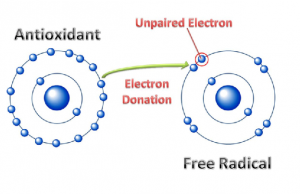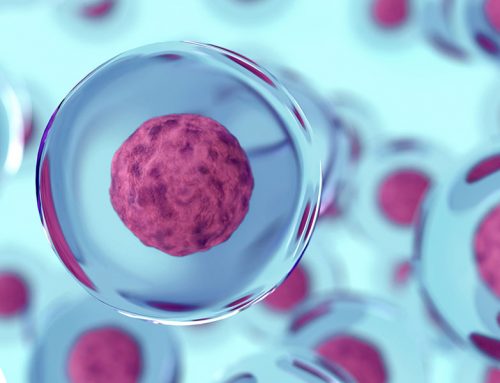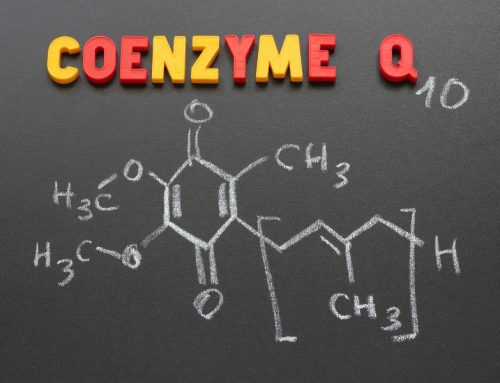The mitochondria are the tiny bean-shaped organelles in our cells. They take the glucose from our food and convert it into ATP energy molecules. Coenzyme Q10 is an essential component in this process of ATP energy generation.

Free radicals are both naturally occurring molecules created in our cells and stressors that enter our bodies from the environment, e.g., from cigarette smoke, environmental pollutants, certain medications, ozone, and ultraviolet radiation. Attribution: Lobo V, Patil A, Phatak A & Chandra N. CC BY-SA 4.0, via Wikimedia Commons.
The mitochondria are also major sources of free radical production in the cells. Free radicals are unstable molecules that take electrons from other molecules, which then become unstable. In moderate quantities, these free radicals have a role to play in cell signaling processes.
Free Radicals and Degenerative Diseases and Aging
However, the balance can easily be lost between the harmful free radicals and the antioxidants needed to neutralize them. Then, the free radicals can damage DNA molecules, lipids, and proteins in the body. Out-of-control free radicals cause oxidative damage. The oxidative stress has been linked to the development of degenerative diseases and to signs of aging [Mantle & Martin 2023].
Coenzyme Q10 is a Lipid-Soluble Antioxidant
It is here that Coenzyme Q10 has a protective function. Coenzyme Q10 in its reduced form — called ubiquinol — is a lipid-soluble antioxidant similar to vitamin E. Vitamin C, by contrast, is a water-soluble antioxidant. Selenium is an essential component of selenium containing antioxidant selenoenzymes such as the glutathione peroxidases and the thioredoxin reductases. Antioxidants neutralize the harmful free radicals and stop the oxidative damage.
Coenzyme Q10 and Heart Disease
Heart disease is characterized by mitochondrial dysfunction and oxidative stress. Coenzyme Q10 is best known for its beneficial heart health effects:
- improving the symptoms and survival of chronic heart failure patients when used as an adjuvant therapy [Mortensen 2014
- reducing cardiovascular mortality of senior citizens when used as a supplement combined with selenium [Alehagen 2013]
Coenzyme Q10 and Other Diseases
In recent years, reviews of the bio-medical research literature have shown that supplementation with Coenzyme Q10 may be beneficial in other diseases that are also affected by mitochondrial dysfunction and oxidative stress:
- endocrine disorders [Mantle & Hargreaves 2023]
- neurodegenerative disorders [Mantle & Hargreaves 2022]
- immune system disorders [Mantle 2021]
- liver disease [Mantle & Hargreaves 2020]
- renal disease [Hargreaves et al 2019]
- critical illness [Hargreaves & Mantle 2019]
- diabetes [Mantle 2017]
The Bio-Synthesis of Coenzyme Q10
Coenzyme Q10 has vitamin-like qualities and properties. However, it is not classified as a vitamin because the body can and does synthesize Coenzyme Q10. In fact, the body synthesizes Coenzyme Q10 in the same biological pathway as it synthesizes cholesterol. For this reason, statin medications and red yeast rice supplements that inhibit the body’s production of cholesterol will also adversely affect the bio-synthesis of Coenzyme Q10 [Okuyama 2015].
Furthermore, it is known that the body’s synthesis of Coenzyme Q10 declines with increasing age in the middle-age and senior years [Kalén 1989]. The decline in the endogenous production of Coenzyme Q10 varies from organ to organ. One estimate is that the CoQ10 production in heart muscle tissue at age 65 is, typically, 50% of the corresponding CoQ10 production at age 25 [Mantle & Martin 2023].
It is not possible to make up for the declining endogenous supply of Coenzyme Q10 by eating more wisely. Supplementation with a well-documented CoQ10 supplement is necessary [Judy 2021].
Formulation of the CoQ10 Supplement
A 2019 comparative bioavailability study has shown that the formulation of the CoQ10 supplement is decisive to its uptake in the gut. The study shows that the formulation of the supplement is more important than the form of the Coenzyme Q10 used in the supplement. Whether the Coenzyme Q10 in the supplement is in the oxidized form (ubiquinone) or in the reduced form (ubiquinol) is less important. Of primary importance to absorption and bioavailability is the employment of a process that results in the dissolution of the CoQ10 crystals to single molecules at body temperature [Lopez-Lluch 2019; Mantle & Dybring 2020].
The Chemical Structure of Coenzyme Q10
The reason for needing a proven manufacturing process is simple. The CoQ10 raw material is crystalline in form. The human body cannot absorb Coq10 crystals. The crystals must be dissolved to single molecules and must be absorbed as single molecules in the gut [Mantle 2023].
Not only that but CoQ10 molecules are very hydrophobic, making the transfer in the watery environment of the small intestines to the intestinal absorption cells difficult.
Conclusion: Coenzyme Q10 an Essential Supplement for the Mitochondria
Coenzyme Q10 belongs in the top tier of supplements – together with vitamin D supplements and fish oil supplements.
- Coenzyme Q10 is an essential component in the process of ATP energy generation.
- Coenzyme Q10 is an important lipid-soluble antioxidant.
- Coenzyme Q10 is difficult to absorb and requires a scientifically tested formulation to be effective.
Sources
Alehagen U, Johansson P, Björnstedt M, Rosén A, Dahlström U. Cardiovascular mortality and N-terminal-proBNP reduced after combined selenium and coenzyme Q10 supplementation: a 5-year prospective randomized double-blind placebo-controlled trial among elderly Swedish citizens. Int J Cardiol. 2013 Sep 1;167(5):1860-6.
Judy WV. The Instability of the Lipid-Soluble Antioxidant Ubiquinol: Part 3-Misleading Marketing Claims. Integr Med (Encinitas). 2021 Dec;20(6):24-28.
Kalén A, Appelkvist EL, Dallner G. Age-related changes in the lipid compositions of rat and human tissues. Lipids. 1989 Jul;24(7):579-84.
Hargreaves IP, Mantle D. Supplementation with selenium and coenzyme Q10 in critically ill patients. Br J Hosp Med (Lond). 2019;80(10):589-593.
Hargreaves I., Mantle D., Milford D. Chronic kidney disease and coenzyme Q10 supplementation. J. Kidney Care. 2019;4:82–90.
Hargreaves I, Heaton RA, Mantle D. Disorders of human Coenzyme Q10 metabolism: An overview. Int J Mol Sci. 2020;21(18):6695.
López-Lluch G, Del Pozo-Cruz J, Sánchez-Cuesta A, Cortés-Rodríguez AB, Navas P. Bioavailability of coenzyme Q10 supplements depends on carrier lipids and solubilization. Nutrition. 2019 Jan;57:133-140.
Mantle D. CoQ10 to treat and prevent heart disease. Br. J. Cardiac. Nurs. 2015;10:382–387.
Mantle D. Coenzyme Q10 supplementation for diabetes and its complications: An overview. Br. J. Diabetes Vasc. Dis. 2017;17:145–148.
Mantle D, Dybring A. Bioavailability of Coenzyme Q10: an overview of the absorption process and subsequent metabolism. Antioxidants (Basel). 2020;9(5):386.
Mantle D, Hargreaves IP. CoQ10 supplementation in non-alcoholic fatty liver disease: an overview. Brit J Gastrointestinal Nursing (Liver nursing supplement). 2020;Suppl:52-57.
Mantle D, Hargreaves IP. Mitochondrial dysfunction and neurodegenerative disorders: role of nutritional supplementation. Int J Mol Sci. 2022;23(20):12603.
Mantle D, Hargreaves IP. Coenzyme Q10 and endocrine disorders: an overview. Antioxidants (Basel). 2023;12(2):514.
Mantle D, Heaton RA, Hargreaves IP. Coenzyme Q10 and immune function: an overview. Antioxidants (Basel). 2022;10(5):759.
Mortensen SA, Rosenfeldt F, Kumar A, Dolliner P, Filipiak KJ, Pella D, Alehagen U, Steurer G, Littarru GP; Q-SYMBIO Study Investigators. The effect of coenzyme Q10 on morbidity and mortality in chronic heart failure: results from Q-SYMBIO: a randomized double-blind trial. JACC Heart Fail. 2014 Dec;2(6):641-9.
Okuyama H, Langsjoen PH, Hamazaki T, Ogushi Y, Hama R, Kobayashi T, Uchino H. Statins stimulate atherosclerosis and heart failure: pharmacological mechanisms. Expert Rev Clin Pharmacol. 2015 Mar;8(2):189-99.
The information presented in this review article is not intended as medical advice. It should not be used as such.









Leave A Comment